Figure 1.
Experimental setting. A, The participants were instructed to make center-out reaching movements while holding the handles of two robotic manipulanda. The position of each handle was visualized as a white cursor on a horizontal screen over the participants' arms. The movement of each handle was constrained to a virtual horizontal plane by a simulated spring. The participants wore a wrist brace on each hand and the upper arms were supported by slings. The trunk of each participant was strapped to a chair. B, Velocity-dependent force fields were generated by the manipulanda. The force is represented as f = Bv, where f = (fx, fy)t (N) is the force to the handle, v = (vx, vy)t (m/s) is the velocity of the handle, and B [N/(m/s)] is the viscosity matrix. For CW force fields, B = [0 − 10; 10 0] and, for CCW force fields, B = [0 10; − 10 0]. C, We used the error-clamp method to quantify motor adaptation. During error-clamped trials, the trajectory of the handle was constrained to a straight line toward the target by a virtual channel in which any motion perpendicular to the target direction was constrained by a one-dimensional spring. This method enabled us to measure directly the lateral force exerted toward the channel. An aftereffect was defined as the difference between the pretraining and posttraining data measured at peak movement speed.

